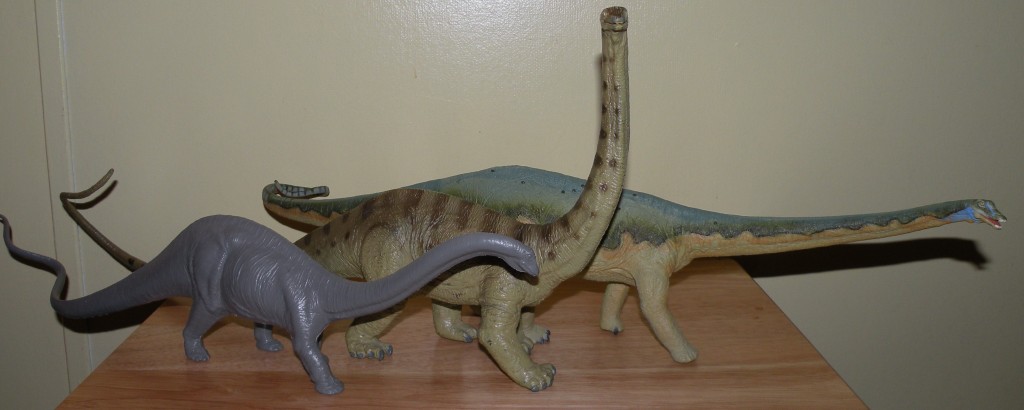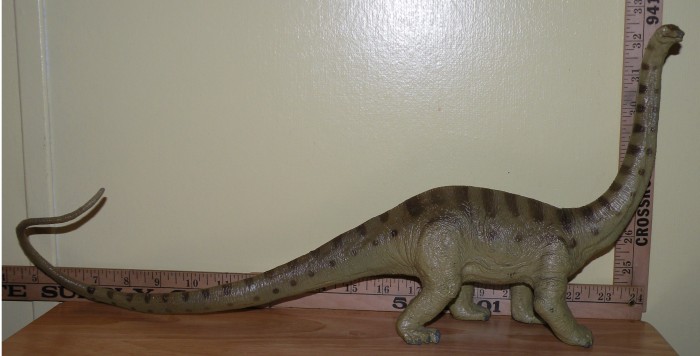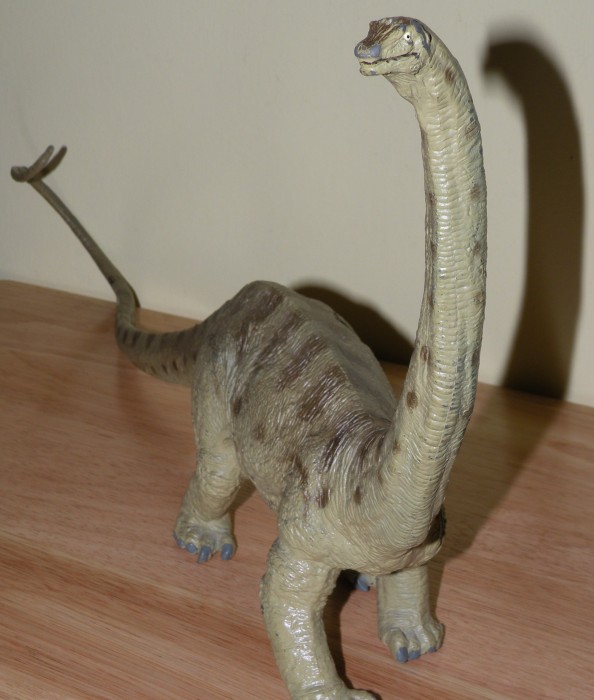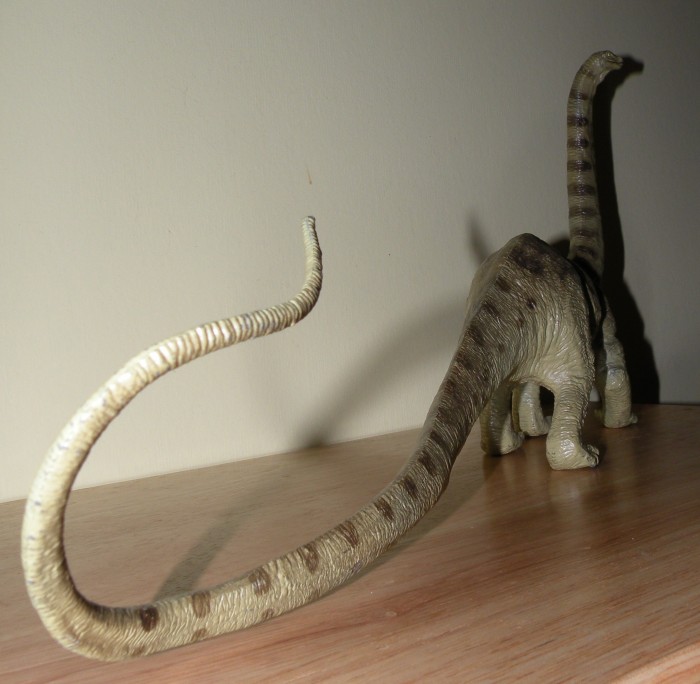Diplodocus is one of those all American sauropods every kid grew up with, right alongside Apatosaurus and Brachiosaurus. Described in 1878 it is still the longest known sauropod from a complete skeleton. It is no wonder then, that the Carnegie Collection would include this animal in their original 1988 lineup of museum quality replicas. In 2008 a new and improved version would be released but this oldie is still a goodie and well worth seeking out. Astute fans of Jurassic Park will have no doubt noticed this figure displayed in the trailer at the dig site in the beginning of the film.
At 24” in length and 9” tall this is a behemoth of a toy and truly conveys the length of these animals. The tail in particular is extremely long and accounts for about 16” of the model’s length, making the tail itself longer than Carnegie’s current representation. Though overall they match each other in scale this Diplodocus has a shorter neck than the new version and despite representing the same animal looks dramatically different. The pose is certainly a relic of another time, when dinosaurs were first leaving the swamps and we were starting to come to grips with how they looked and functioned. The tail is swung low and almost dragging on the ground while the head is held high up in a vertical position. Serious dinosaur buffs will notice inaccuracies like these.
The common depiction for this animal these days is the more horizontal position with the tail held high and the head at shoulder height. They certainly may have been capable of lifting their heads higher even if not quite as high as the old Carnegie does. The head itself is fairly crude, like the other original Carnegie sauropods. The eyes are yellow with black pupils. The mouth is a simple black line. The nostrils are placed high on the head though these days we know this too was incorrect. The feet are outdated as well with five nails painted on each. Only one claw should be evident on the forelimbs and three on each of the hind limbs. This is a common mistake even among toy companies today and I must stress that the age of this figure all but justifies inaccuracies like these.
In texture the model is mostly wrinkly, with few scales. Though a more scaled texture would have felt more appropriate this is common among dinosaur toys and Carnegie in particular. In conjunction with the feet the wrinkled skin gives the dinosaur a very elephantine quality. The choice in colors is subtle but convincing with the majority of the body covered in a light sandy shade of brown, large splotches and spots of a darker drab brown form patterns down the neck, back and tail. This choice in color helps convey the image of an animal that lived in dry, dusty sun baked environments as opposed to the humid swamp lands these creatures were once thought to have lived in. There are probably other versions of this toy with different paint jobs but if so I’m not aware of them. This brown one is certainly the more abundant one if that is the case.

Though outdated in nearly all its major features this figure serves as a reminder of how far we’ve come in understanding these animals and is a fantastic retro piece for any collection. It stands in nicely displayed with the other old Carnegie sauropods or displayed next to the older Invicta model and newer Carnegie. Seeing the two Carnegies next to each other, it is amazing to think these represent the same animal. Who knows what these animals will look like another 20 years from now. Though not as common as the old Apatosaurus and Brachiosaurus, this Diplodocus can still be found on places like eBay from time-to-time.
Support the Dinosaur Toy Blog by making dino-purchases through these links to Ebay and Amazon. Disclaimer: links to Ebay.com and Amazon.com on the The Dinosaur Toy Blog are often affiliate links, when you make purchases through these links we may make a commission




I remember wanting this particular figure SO bad as a kid, first from seeing it on my second grade teacher’s shelf and then because of that fun cameo appearance it makes in Jurassic Park. Never did get one until I was an adult, but I’ve got one now and I’d never part with it. The 2008 Carnegie version is both more accurate and more striking, but this one just has a presence on the shelf that can’t be matched. And it by far surpasses that ugly 2017 “Mr. Ed” Diplodocus.
I have a 1988 diplodocus also but it isn’t the same as this one. The tail is off the ground with the tail following straight behind with a curve upward, has 5 toes on every foot, and the head is upward like this one(shown). It has similar markings but the neck isn’t ringed and the brown spots are more subtle on a light olive background. Maybe there was a transition of this model in 1988.
This is the 1996 re-sculpt of the original 1988 model. Check out the forum to see a comparison of the two Diplodocus models.
Sajnos nem volt szerencsém találkozni ezzel a “legendával”,de nemrég egy bolhapiacon találtam egy minfigurával amelynek megegyezik a szobra vele.Egészen biztos,hogy nem Safaris,de legalább emlékeztet rá.
I have this one and I love it 🙂 It was one of my first carnegies ever
Reminds me of my old college student days. The figure is outdated and the new Carnegie Diploducus is much better other than this ancient production, in fact the Carnegie Diploducus latest version is the best by far of all toy dinosaurs facts of this line.
I still need this one…
Great to see this classic finaly reviewd.
This was one of my first Carnegis. And it was the first time i heard of diplodocus when my Daddy bought for me.